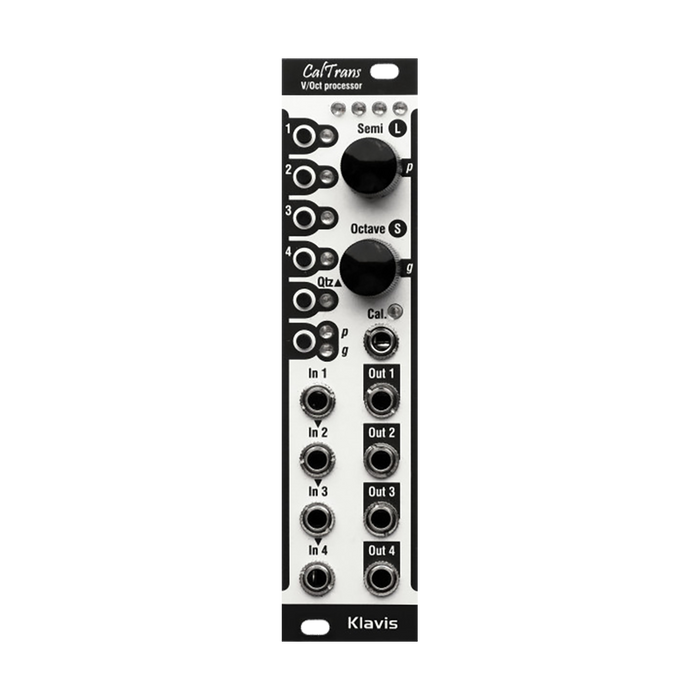
Klavis CalTrans
Format: Eurorack
Width: 6HP
Depth: 36mm
Current: 44mA @ + 12V, 8mA @ -12V
Manual pdf (English)

Format: Eurorack
Width: 6HP
Depth: 36mm
Current: 44mA @ + 12V, 8mA @ -12V
Manual pdf (English)
Klavis CalTrans is a programmable 4-channel V/Oct calibrator and transposer. Consisting of four V/Oct signal processing channels, this unit can be calibrated to correct tracking and extend the range of pitch signals of any VCO, making it suitable for systems with different ranges such as Buchla. can also be used.
Each channel also features semitone transposition, octave shifting, a switchable semitone quantizer, and adjustable portamento and glissando functions.CalTrans is also very useful if you mainly use these functions and perform calibration when necessary.
CalTrans solves problems such as tracking problems, non-V/Oct pitch curves, octave width limitations, and annoying transpositions when playing tonal music in a modular system.Correct/expand the range of difficult-to-use VCOs and add V/Oct tracking to any device that can oscillate.
VCOs that do not require calibration can simply be used in "Neutral" mode to benefit from transposition and other musical features.Two rotary encoders with detent mechanism allow precise octave and semitone selection.For VCOs with significantly poor tracking ability, pitches are repositioned to the highest (lowest) octave possible to maintain overall harmony.Portamento and glissando can be set for each channel, and all of these can be saved in user presets.
The calibration method is simple.Patch the output of the desired channel of Cal Trans to the 1V/Oct input of the VCO you want to calibrate, and patch the VCO's simple waveform output, such as a square waveform or sine wave, to the Cal input of CalTrans.At this point, the Cal LED and all channel LEDs will flash, so press the corresponding channel button to begin calibration. The corresponding channel of CalTrans monitors the output pitch signal and the input sound, and adjusts it so that the VCO responds at 1V/Oct.
When the calibration is complete, the Qtz LED will flash green.Also, the number of lit LEDs arranged horizontally at the top indicates the voltage range that has been calibrated.
"Neutral" calibration method
Even if you do not need to correct V/Oct tracking, performing neutral calibration will allow you to use CalTrans functions such as appropriate transposition.To perform a neutral calibration, patch the output of that channel to the input and disconnect the patch cable from the other channels. Press and hold the Qtz button until the Cal LED flashes. Calibration is successful when the Cal LED lights steadily blue, the Qtz LED blinks, and the LED of the calibrated channel lights up.Finally, remove the patch to the input jack to complete the calibration.
Select a channel and shift the pitch signal by semitones with the Semi encoder or octaves with the Octave encoder.A restriction has been added to prevent shifting beyond the calibrated range.If you want to clear the transposition, press both encoders at the same time.
Press the Qtz button to display the quantizer settings page, then press the button for the channel you want to quantize.
To load a preset, briefly press the top encoder.The current preset's yellow LED and all red LEDs will flash.Press one of the channel buttons (1-4) to load the corresponding preset (1-4).The corresponding yellow LED will flash briefly to indicate that the preset has been loaded.
To save a preset, briefly press the bottom encoder.The current preset's yellow LED and all red LEDs will flash.Press any of the channel buttons (1-4) to save to the corresponding preset (1-4).The corresponding yellow LED will flash briefly to indicate the preset has been saved.